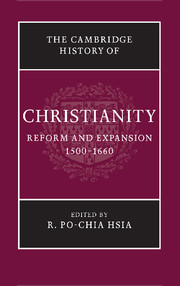Book contents
- Frontmatter
- Part I Luther and the Holy Roman Empire
- Part II The Second Reformation
- Part III Catholic Renewal
- 9 Redefining Catholicism: Trent and Beyond
- 10 New religious orders for men
- 11 Female sanctity, 1500–1660
- 12 Tridentine worship and the cult of saints
- Part IV Resolving Confessional Conflicts
- Part V Religion, Society, and Culture
- Part VI Christianity and Other Faiths
- Bibliography
- Index
- References
11 - Female sanctity, 1500–1660
from Part III - Catholic Renewal
Published online by Cambridge University Press: 28 March 2008
- Frontmatter
- Part I Luther and the Holy Roman Empire
- Part II The Second Reformation
- Part III Catholic Renewal
- 9 Redefining Catholicism: Trent and Beyond
- 10 New religious orders for men
- 11 Female sanctity, 1500–1660
- 12 Tridentine worship and the cult of saints
- Part IV Resolving Confessional Conflicts
- Part V Religion, Society, and Culture
- Part VI Christianity and Other Faiths
- Bibliography
- Index
- References
Summary
Introduction
During the Renaissance and early modern period, female religious life emerged with extreme vivacity. Scholars agree that both the socio-economic and juridical condition of women’s lives deteriorated during the Renaissance. They also agree that religion, on the other hand, provided a means for different forms of female affirmation to offset and even-out the misogynist cultural currents that were present and driven by churches. Socially, sanctity was valued and was pursued both by licit means, that is, means relevant to the very nature of religious faith, and by illicit.
Between 1500 and 1660, women expressed their religiousness according to traditional models that were valued differently as the political, social, and cultural situations proposed and imposed new conditions of life upon them. At the same time, religious conflicts and the plurality of religions generated new models of sanctity but at times reproduced the old ones. Considering the universality of the aforementioned problems, I intend to trace the evolutionary lines of female sanctity, starting with the most representative experiences of religious life during the period indicated, and to proceed in chronological order. I will not consider the approved model of sanctity exclusively, but will bear in mind the proscribed as well, while also referring to counter-models.
In outlining the evolution of female sanctity, I will avail myself of traditional representations of Christianity while demonstrating the active role of women in interpreting such representations or in generating new ones. The models can be found in some principal chronological periods: the first decades of the sixteenth century; the period of the Protestant Reformation and the Council of Trent; and the period of the Counter-Reformation and Catholic renewal.
Models of female sanctity in the first decades of the sixteenth century: mystical and prophetic sanctity
- Type
- Chapter
- Information
- The Cambridge History of Christianity , pp. 180 - 200Publisher: Cambridge University PressPrint publication year: 2007



